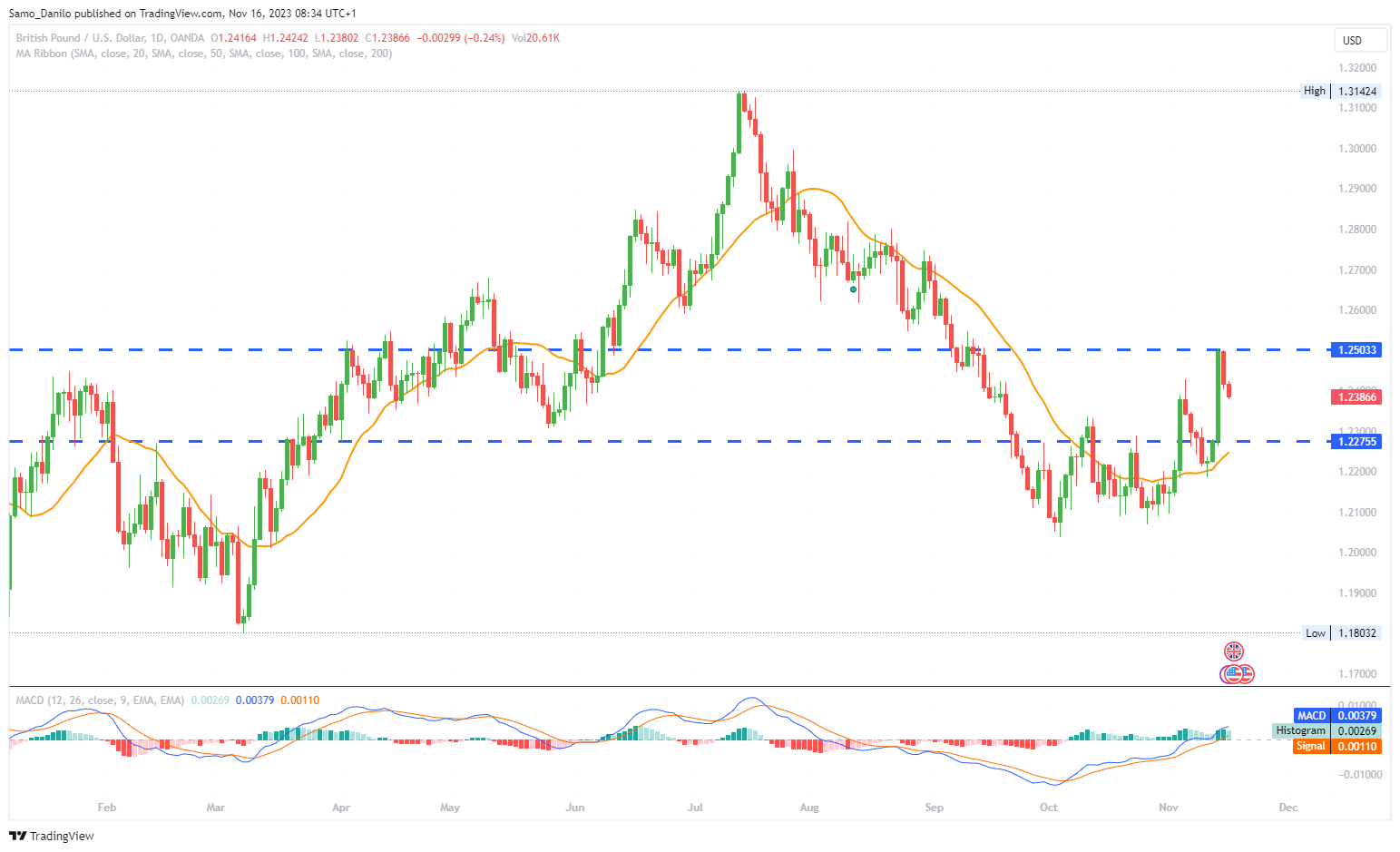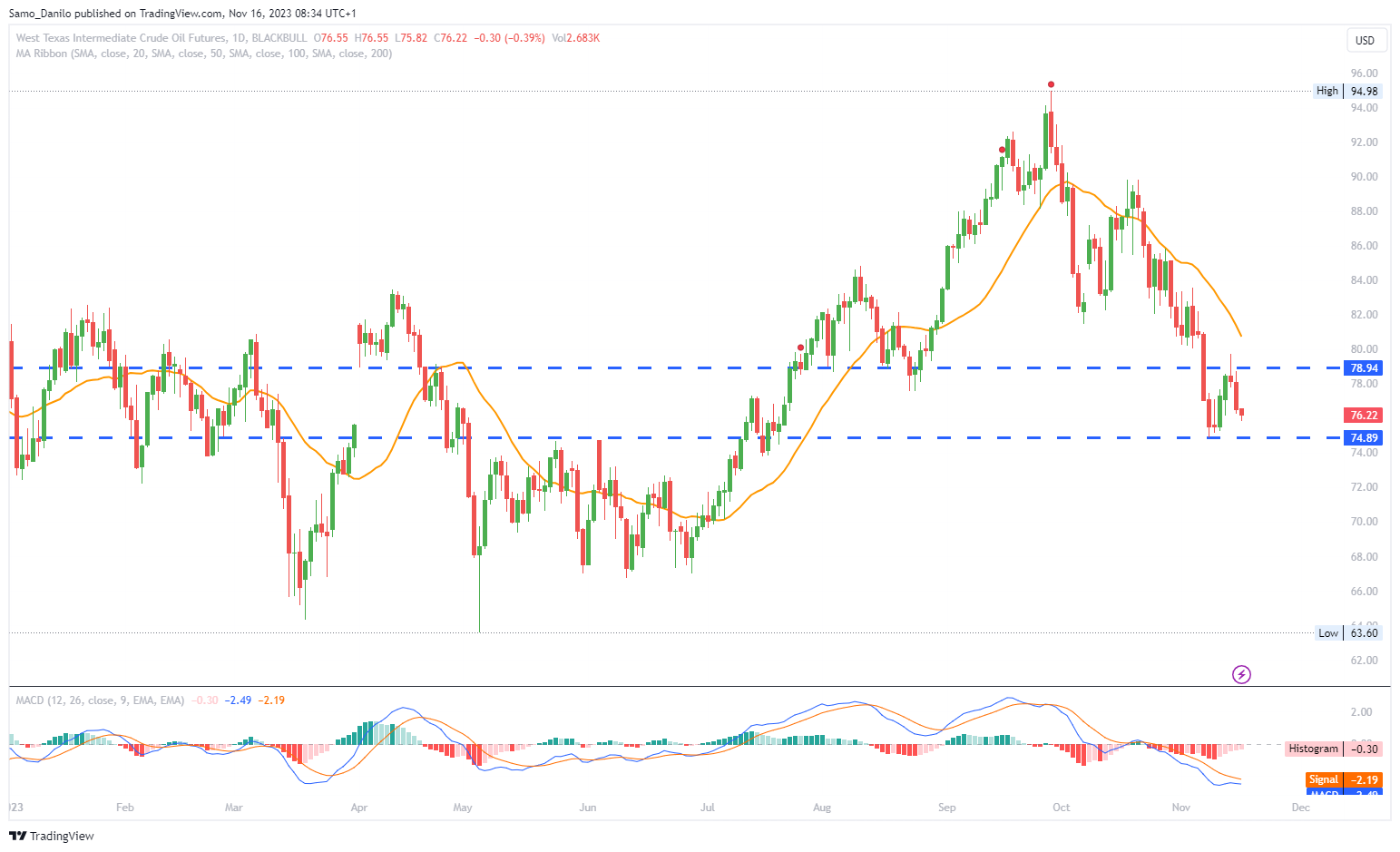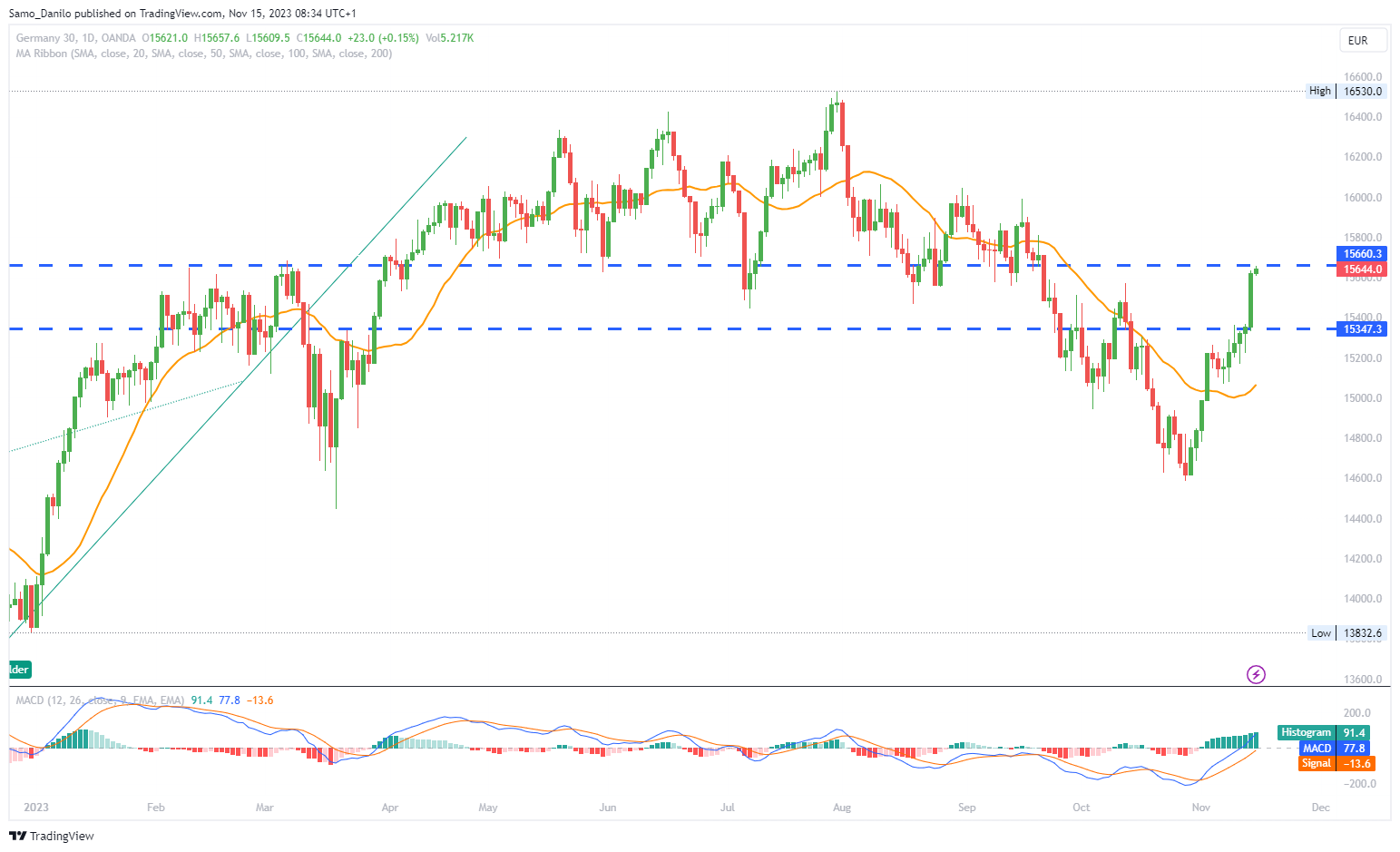EURUSD
- The EUR/USD pair experienced a loss of traction during Asian trading hours on Thursday, primarily due to renewed demand for the US Dollar. The strengthening of the US Dollar weighed on the EUR/USD pair.
- The US Producer Price Index (PPI) for October showed a decline of 0.5%, contrary to expectations of a 0.1% increase. The annual rate also slowed from 2.2% to 1.3%, and the annual Core PPI fell from 2.7% to 2.4%. This data indicates a cooling of inflation, alleviating pressure on the Federal Reserve (Fed) to raise interest rates further.
- Another report revealed that Retail Sales fell by 0.1% in October, which was a better reading than the expected 0.3% decline. The positive aspect of this data suggests resilience in consumer spending.
- On Thursday, economic data from the US includes the weekly Jobless Claims, Industrial Production, and the Philly Fed report. These releases can provide additional insights into the economic conditions in the US and influence market sentiment.
- The retracement in the EUR/USD pair is described as modest and is seen as a corrective move. The negative sentiment towards the Dollar reflects market expectations that the Fed will not raise rates again, given the easing inflationary pressure.
Closing statement:In summary, renewed US Dollar demand, coupled with data indicating a cooling of inflation, influenced the EUR/USD pair. The upcoming US economic data releases will be closely monitored for further insights into the economic landscape and potential impacts on the EUR/USD pair.
GBPUSD
- The GBP/USD pair extended its losses for the second consecutive day, trading lower around 1.2390 during the Asian session on Thursday.
- From a technical standpoint, the 1.2350 major level is highlighted as a key support, with the next support identified around the psychological level at 1.2300.
- Despite the inflation numbers from the previous day, the losses in GBP/USD remain limited. The weakness in the US Dollar (USD) is mentioned, reflecting growing market expectations for a Federal Reserve (Fed) policy shift in the second half of 2024.
- The Bank of England (BoE) is expected to be encouraged by the inflation print, which shows headline inflation at a two-year low. The mention of inflation being below the 5% level is noteworthy, marking a significant decrease from a peak of 11.1% in October 2022.
| SMA (20) | Slightly Rising |
| |
| RSI (14) | Slightly Rising |
| |
| MACD (12, 26, 9) | Rising |
|
|
Closing statement: the GBP/USD pair is experiencing extended losses, but these losses remain limited despite lower inflation numbers. The technical support levels and the interplay between the USD weakness and BoE's perspective, along with market expectations, contribute to the overall dynamics of GBP/USD. The market will likely keep a close eye on future economic data and central bank communications for further guidance.
GOLD
- Gold attracted dip-buying during the Asian session on Thursday, showing signs of a retracement from a recent one-week high around the $1,975-1.976 area.
- Gold is encountering resistance around the 20-day Simple Moving Average (SMA) at $1,973. The bulls are noted to need a decisive break above this level to potentially pave the way for further gains.
- The inflation readings are highlighted, aligning with the Consumer Price Index (CPI) data released on Tuesday. These readings suggest a cooling of inflation. Additionally, Retail Sales data for October is mentioned, showing a decline of 0.1%, which is less steep than the expected 0.3% slide.
- The report mentions that risk appetite remains present, US bonds are firm, and there is an ongoing vulnerability of the dollar. These factors are noted as potentially supporting further gains in Gold.
- On Thursday, the US is set to release several economic indicators, including the weekly Jobless Claims report, Industrial Production, and the Philly Fed Manufacturing Index. It's highlighted that positive numbers from these releases could weaken demand for Treasury bonds, leading to higher yields, which might, in turn, weigh on Gold.
| SMA (20) | Rising |
|
|
| RSI (14) | Slightly Rising |
| |
| MACD (12, 26, 9) | Slightly Falling |
|
Closing statement: Gold is experiencing dip-buying after reaching a recent one-week high. The 20-day SMA poses as a resistance level, and the market is attentive to economic indicators, particularly those related to inflation and bond yields. The ongoing dynamics of risk appetite and the dollar's vulnerability are also influencing the precious metal. Traders are likely monitoring upcoming economic data for further cues on Gold's direction.
CRUDE OIL
- Western Texas Intermediate (WTI) is trading lower near $76.30 per barrel during the Asian session on Thursday, extending losses for the third successive day. Crude oil prices have been on a downward trend for the fourth consecutive week.
- The losses in crude oil prices are attributed to investors factoring in a reduced risk premium related to the Middle East conflict.
- The downward pressure on oil prices is intensified by a larger-than-expected weekly build in US crude stockpiles. The EIA Crude Oil Stocks Change for the week ending on Nov 10 showed an improvement to 3.6 million barrels from 0.774 million barrels prior, against the expected 1.793 million barrels.
- Signs of easing demand in China are noted as contributing to the negative sentiment surrounding oil prices. China's oil refinery throughput in October experienced a slight slowdown from the previous month's highs.
- The decision by the US to enforce oil sanctions on Iran, reducing Iranian oil exports, is highlighted. President Joe Biden's energy security adviser, Amos Hochstein, expects the enforcement of these sanctions to result in a reduction of more than 1 million barrels per day (bpd) of oil exports from Iran.
| SMA (20) | Falling |
|
|
| RSI (14) | Slightly Falling |
| |
| MACD (12, 26, 9) | Slightly Falling |
|
Closing statement:Crude oil prices, particularly WTI, are on a downward trend for the third successive day and the fourth consecutive week. Factors contributing to these losses include a reduced risk premium related to the Middle East conflict, a larger-than-expected build in US crude stockpiles, signs of slowing demand in China, and the impact of US sanctions on Iranian oil exports. Traders are likely monitoring these factors closely for insights into the future direction of oil prices.
DAX
- Economic indicators from China on Wednesday were mentioned as a driver for demand in riskier assets. Better-than-expected retail sales and industrial production figures in China suggested that stimulus measures were taking effect.
- On the other hand, Eurozone industrial production and trade data fell short of market expectations on Wednesday. Industrial production declined by 1.1%, and the trade surplus widened from €6.7 billion to €10.0 billion.
- On Thursday, ECB President Christine Lagarde is expected to be in the spotlight. Given the recent economic indicators, comments from Lagarde relating to the economic outlook and interest rates will be closely watched.
- ECB Executive Board members Andrea Enria and Luis de Guindos are also scheduled to speak. The input suggests that less hawkish forward guidance on the ECB rate path could potentially support buyer demand.
- Fed speakers could prove pivotal to the Thursday session. Fed Vice Chair John Williams and FOMC members Michael Barr, Lisa Cook, Loretta Mester, and Christopher Waller are scheduled to speak. The market's reaction to recent inflation and retail sales figures will also be a point of consideration.
| SMA (20) | Rising |
|
|
| RSI (14) | Rising |
|
|
| MACD (12, 26, 9) | Rising |
|
|
Closing statement: In summary, DAX movements are influenced by a combination of global economic indicators, with a focus on Chinese data, Eurozone indicators, and upcoming speeches from ECB and Fed officials. Traders are likely closely monitoring these events for insights into the economic outlook and central banks' policy stances, which could impact the direction of the DAX.




